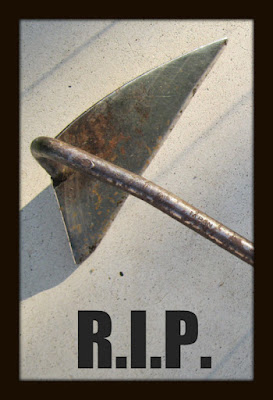 |
| Heliconia pendula |
I must have dozed off in the hammock Sunday after
spending one too many hours weeding in the 90-degree heat.
When I woke up, I was in an island paradise surrounded by tropical plants. There were no weeds in sight. All the beds
were immaculately edged and mulched. The smell of gardenias and jasmine perfumed the air.
It was heavenly! I immediately had to take a closer look.
“This is better than Butchart Gardens on Vancouver Island,”
I thought as I got up and went for a short stroll, “although they do serve afternoon tea at Butchart.”
Suddenly, a very short man in a white suit was there,
offering me a tall glass of ice cold lemonade. He left before I could thank
him, saying something about a plane.
Then, over to my left, I saw a bright red and yellow flower
that looked like a lobster claw. As I walked toward it, I suddenly knew what it
was.
Heliconia pendula, better known as lobster-claw. Named
after Mount Helicon, the seat of the Muses in Greek mythology. Spreads by
rhizomes. “Flowers” are actually bracts. Likes at least 6 hours of sun although
the pendulous version prefers shadier areas. Needs to be watered at least twice
a day.
Wow, I thought. The only tropical plants I've ever owned have been the hibiscus on our deck. Where did that come from? Hmmmmm….
Over to my right was a palm with ruffled, fan-like leaves. As I walked over, the same thing happened.
 |
| Licuala grandis |
Licuala grandis. Also known as the Ruffled Fan fern. Native to the Vanuata Islands off
the coast of Australia. Doesn’t like direct sun. Slow grower. Prefers high
humidity. Good as a houseplant. Produces red berries,
each with a single seed.
This was starting to become a bit disconcerting.
Maybe I just needed to stretch my legs a bit more in order to wake up. I had walked about a quarter mile when I saw a wonderful purple flower with white edges straight ahead.
 |
| Duranta erecta 'Sapphire Showers' |
Duranta erecta 'Sapphire Showers.' A member of the verbena family. Also known as Picotee Skyflower, Pigeonberry or Golden Dewdrop. The later name is because the flowers are succeeded by chains of orange-yellow fruit. Fruit is poisonous, so do not put where it is accessible to children. Likes average soil and full to part sun.
I’ve always wanted to know everything about every plant I
see, but this was starting to become a bit much.
 |
| Jamie Durie |
Out of the corner of my eye, I spotted a man with brown hair carrying an Australian tree fern (Cyathea cooperi or so my brain
instantly told me). Was that Jamie Durie, the hunky Australian garden designer
from HGTV? Maybe he could tell me what was going on here.
Unfortunately, he vanished
before I could reach him. It was as though he had disappeared into a room of
some sort.
I shrugged it off and resumed my walk. Flowers and ferns were everywhere on this island. And somehow I instantly knew exactly
what they were, simply by looking at them.
There was the thyallis (galphimia glauca), Firecracker fern (Russelia equisetiformis), Kimberly Queen fern (Nephrolepis obliterata) and even Macho fern (N. biserrata). In no time, my poor brain was overloaded.
 |
| Russelia equisetiformis |
Finally, in a shady glen just ahead, I spotted a hammock
slung between two coconut trees. Maybe I could just close my eyes and take a short break, I thought as I climbed in.
When I woke up a short time later, I was in my own back yard, weeds and all.
My mind was at peace, though. And my husband was standing there with some sort of potted palm in one hand and a virgin Pina Colada for me in the other.
Maybe my own little garden wasn't so bad after all. Especially if I added a touch of the tropics this summer.
HGTV's Jamie Durie will be appearing at Chalet Nursery this
Thursday, June 14 from 2 to 3 p.m. and again from 6:30 to 8:30 p.m. The cost is $24.95 and includes a copy of his latest book,
The Outdoor Room. For more information, call (847) 256-0561.
 |
| Agave schidigera 'Durango Delight' |
 |
| Aloe hybrid 'Christmas Carol' |
 |
| Heliconia species or False Bird of Paradise |
 |
| Acalypha wilkesiana or Copper Leaf |
 |
| The foliage of Melianthus major 'Antonow's Blue' |
By Karen Geisler
















